For this mega-series in DIY home inspections, I started with the inspection of almost everything on the outside of the home. I covered roofs, chimneys, water management, siding, and everything else in-between. Today I’ll cover electrical. There is a ridiculous amount of stuff that could be covered with this topic, and a lot of it takes a lot of explaining. Instead of trying to cover it all, which I couldn’t possibly do, I’ll cover the stuff that takes the least amount of explaining and makes the biggest impact on safety.
Overhead Wires
If your home has overhead wires bringing in power, check to make sure there are no tree branches rubbing on the wires. It’s the homeowner’s responsibility to maintain trees on the property that may interfere with the overhead wires coming from the utility pole to the house.
Also, take a close look at the connection point between the overhead wires right before they disappear into the masthead. One wire is the neutral wire; it’s normal for this wire to be exposed, but the other two wires shouldn’t have any exposed contacts. If there are, these are serious shock or electrocution hazards that should be repaired by the utility company. The photo below gives an example of an exposed ferrule at one of the hot wires. Touch that thing with an aluminum ladder, roof rake, or something similar, and it’ll be lights out for
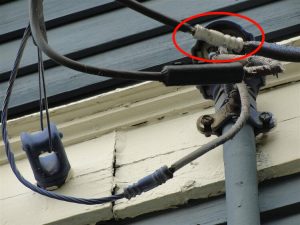
For more examples of exposed conductors at this location, and for a more in-depth discussion of these issues, click here: Tree Branches, Exposed Power Lines: Who Fixes What
Outlets
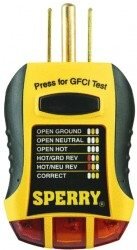
To test the outlets (aka receptacles) at your home, go buy yourself an outlet tester. These are sold at all home improvement stores and hardware stores for about $5, or a little more if the tester comes with a GFCI tester. A GFCI tester makes it much easier to verify that non-GFCI outlets in your home are GFCI protected, but this is not a valid way to test GFCI outlets. More on that topic below.
So now that you have a tester, go around and test all of the outlets in your home. The light codes displayed by the tester will tell you if the outlet is properly wired, or what the problem is if the outlet isn’t properly wired.
Side note: these types of testers will not identify all potential wiring problems, such as a false ground or an outlet with both reversed polarity and an open ground, but they’ll probably identify about 99% of the problems that exist.
Here are the potential readings that an outlet tester will give you:
- Open Ground – more commonly described as an ungrounded three-prong outlet. Click this link for information about how to correct an ungrounded three-prong outlet. This is a condition that should be repaired by an electrician.
- Open Neutral – this is a very uncommon defect; it means there is power at the outlet, but whatever is plugged into the outlet won’t work. Every once in a while, this is the result of a switched neutral wire.
- Open Hot – there’s no “hot” wire at the outlet… or there’s a live hot and no neutral and no ground. Whatever is plugged into the outlet won’t work. Sometimes this might be the result of a switched outlet and the switch is just off, but in many cases it just means it’s a dead outlet.
- Hot/GRD Rev – this is an extremely scary condition that I don’t think I’ve ever actually come across. Plugging in a tool with a three-prong cord would instantly energize the housing of the tool, making it an electrocution hazard. If you find this condition at a GFCI outlet, hit the “test” and then the “reset” button on the outlet and test it again. GFCI outlets will occasionally give funny readings that are not correct.
- Hot/Neu Rev – more commonly described as reversed polarity. Click this link for information about reversed polarity. This is a shock hazard that should be repaired by an electrician.
Every once in a while you’ll get a different reading, such as all three lights lit up, or a bright middle light and dim lights on the left and right. These readings indicate problems that should be looked into further by an electrician.
If there are loose outlets, the repair is usually as simple as removing the cover plate and tightening the screws that hold the outlet in place.
Test all of the GFCI devices in your home to make sure they’re functional, and replace them if they’re not. This is something that’s supposed to be done every month… and I’m sure that everyone who reads this blog already does this, right? But just in case, here’s a short video clip from Leviton showing how to do it.
Also, make sure that there is GFCI protection for the outlets where you’re most likely to get electrocuted. These areas include bathrooms, garages, unfinished basements, the exterior, and many other places near water. Click the following link for more information about testing GFCI outlets. Oh, and if you press the test button and the outlet makes a buzzing noise, the outlet has gone bad and should be replaced.
Cover Plates
Not only do cover plates help to prevent accidental shocks, but they help to contain any arcing or sparking that might take place within an electrical box, thus potentially preventing a fire. Go through your home and make sure there are cover plates installed for all of the outlets, switches, and junction boxes. A few of the more common places for missing cover plates are in unfinished basement areas, behind refrigerators, inside kitchen cabinets, and at garage ceilings.
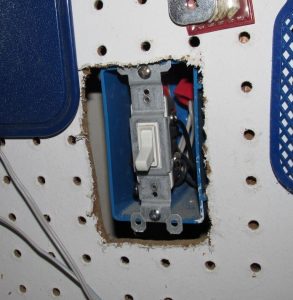
While this is usually a very simple DIY repair, the photo above shows a situation where the fix isn’t quite so simple; if a cover plate was installed over the pegboard, it would leave a gap between the box and the cover that could allow sparks to escape and potentially start a fire. The fix for this situation would actually involve cutting away the pegboard a little more so that a cover plate could be installed tight against the box, or installing a box extender.
Extension Cords
Permanently installed appliances should be plugged directly into their own outlets, not extension cords. Using extension cords increases the potential for a fire. A few of the more common places to find extension cords used in lieu of permanent wiring are garage door openers, water softeners, and basement lights.
Wiring
Uncapped, improperly terminated wires are an immediate shock/electrocution hazard that should be dealt with immediately. Always assume these wires are live.
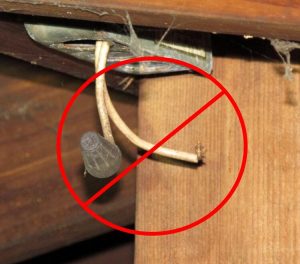
Open spliced wiring is a potential fire hazard.
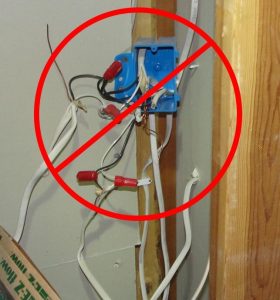
Wooden boxes don’t cut it either; wire splices should take place within proper electrical boxes.
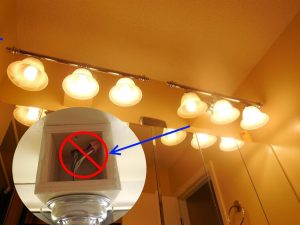
Wiring defects are probably best left up to an electrician for repair.
Openings in Boxes and Electric Panels
Unused openings in electrical boxes and electric panels should always be covered. These openings create potential shock hazards, they might not properly contain a fire that could occur within the box, and can admit unwanted visitors such as mice.
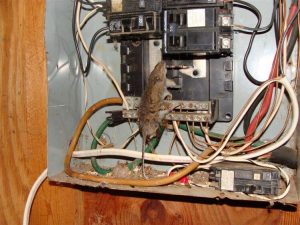
These types of defects are very much a DIY type of repair; for information on how to correct these issues, click here: Missing Knockouts
Smoke Alarms
Check to make sure your home has smoke alarms installed inside each bedroom, smoke alarms installed in common areas on each level, and make sure they’re properly located; the diagram below shows where smoke alarms should be located on walls and ceilings.
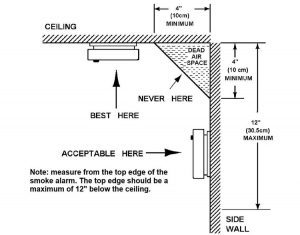
Test smoke alarms monthly, and replace the batteries annually.
Replace any smoke alarms over 10 years old. To check the date, take the smoke alarm down and look on the back. If you can’t find a date, assume it’s over 10 years old and replace it.
Please please please make sure your home is equipped with photoelectric smoke alarms. If you don’t know what type of smoke alarms you have, I can just about guarantee they’re not photoelectric, as I’ve found that the vast majority of smoke alarms are not. While photoelectric smoke alarms are not required, I believe they should be, and I consider this to be an important life safety issue. Click this link for more information about the importance of photoelectric smoke alarms: Photoelectric Smoke Alarms.
For more details and tips on smoke alarm safety, click here: Four Smoke Alarm Safety Tips.
Carbon Monoxide Alarms
The current standard for safety is to have CO alarms installed within 10′ of every sleeping room. CO alarms used to be good for either five or seven years, but Kidde now offers CO alarms that are good for 10 years. If the CO alarms in your home are over 10 years old, they should definitely be replaced. If they’re over five years old… maybe.
Next week, the topic will be homeowner plumbing inspections.
Click on any of the links below to see the past topics in this series:
- How to Inspect Your Own House, Part 1: Roof and Chimney
- How to Inspect Your Own House, Part 2: Exterior Water Management
- How to Inspect Your Own House, Part 3: Siding
- How to Inspect Your Own House, Part 4: The Rest of the Exterior
